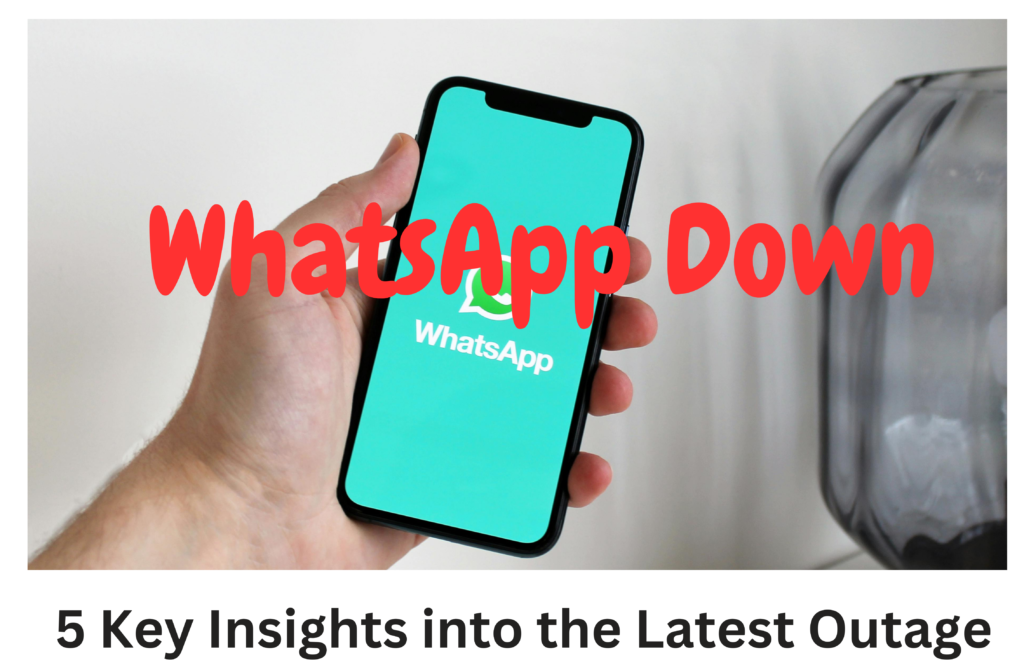
WhatsApp Down:In an increasingly connected world, disruptions to digital communication services can feel like seismic events. WhatsApp, the world’s leading messaging platform with over 2 billion active users, recently experienced a significant outage that left countless people unable to send or receive messages. This unexpected breakdown quickly became a trending topic on Google and sparked heated discussions across social media platforms. From memes to real concerns, the outage highlighted how deeply ingrained this app has become in our daily lives.
What Happened During the Outage
The outage, which lasted several hours, began impacting users worldwide—from the United States and Europe to parts of Asia and Latin America. Most affected users reported issues connecting to the app’s servers, which rendered them unable to send or receive messages in personal or group chats. Additional features like WhatsApp Web and file-sharing functionalities were also rendered nonfunctional.
Parent company Meta Platforms, which also owns Facebook and Instagram, promptly acknowledged the issue through official channels, assuring users that their technical teams were working to restore service. However, the company refrained from disclosing the specific cause of the disruption. Speculations ranged from server overloads to software glitches and even maintenance activities that might have inadvertently gone wrong.
What Happened During the WhatsApp Down Outage?
As soon as the outage became evident, users flooded other social media platforms to express their reactions. Hashtags like #WhatsAppDown and #WhatsAppOutage dominated trending lists on platforms such as Twitter (now rebranded as X). Some users shared their frustration, while others seized the moment to create humorous memes, poking fun at the situation and the universal dependence on WhatsApp.
Many users turned to alternative messaging apps like Telegram and Signal as temporary solutions, leading to a surge in downloads for these platforms. Businesses relying heavily on WhatsApp for customer engagement and internal communications voiced their concerns more seriously. Delayed responses, missed opportunities, and disrupted workflows underscored the cost of such outages, particularly for small enterprises and customer-centric operations.
For some individuals, the disruption served as an unintended “digital detox.” Users reflected on how dependent they’ve become on constant connectivity, with a few even welcoming the brief respite from incessant notifications.
The Immediate User Reaction to WhatsApp Down

This outage serves as a stark reminder of how much we rely on digital tools for personal, professional, and even societal interactions. WhatsApp’s immense popularity stems from its user-friendly interface, end-to-end encryption, and widespread adoption. However, with such dominance comes a heavy responsibility for the platform to maintain uninterrupted service.
Incidents like these underscore the vulnerabilities inherent in digital infrastructure. Even with significant investments in robust server systems and cybersecurity, no platform is immune to technical failures. For Meta Platforms, maintaining user trust necessitates transparency about the root causes of such outages and the steps being taken to prevent them in the future.
How Users Can Prepare for Future Outages
While outages are inevitable in the digital age, there are practical steps users can take to minimize disruptions during such events:
- Stay Informed: Check official announcements from WhatsApp or Meta Platforms via their social media accounts or website. These sources often provide real-time updates and reassurance during service interruptions.
- Use Downtime Trackers: Websites like DownDetector can help confirm whether the issue is widespread or localized to specific regions.
- Have Backup Communication Options: Keep alternative messaging apps like Telegram, Signal, or even basic SMS services on hand for emergencies. Email can also serve as a reliable fallback.
- Communicate Offline: Don’t underestimate the value of a quick phone call or in-person meeting when digital channels are unavailable.
- Be Patient: Outages are typically resolved within a few hours. Instead of stressing over the inconvenience, take the opportunity to step away from screens.
The Role of Tech Giants in Ensuring Reliability
As the world becomes increasingly dependent on digital platforms, tech companies like Meta face mounting pressure to deliver consistent reliability. WhatsApp, in particular, has become indispensable for personal conversations, professional dealings, and even governmental communications in some regions. A disruption can have ripple effects that impact not just casual users but also businesses, healthcare services, and education systems.
Investments in infrastructure, regular audits of system vulnerabilities, and transparency during crises are critical for maintaining user trust. Additionally, offering clear timelines and follow-ups after an outage helps mitigate frustration and restores confidence in the platform’s reliability.
The Human Element: How We React and Adapt
Beyond the technical implications, WhatsApp outages reveal much about our societal behavior. For many, the inability to access the app triggers anxiety over missed opportunities or unresponsive colleagues. For others, it’s a chance to connect in ways that don’t involve digital devices—whether it’s spending time with loved ones or engaging in offline hobbies.
The humor that often accompanies these events also reflects our collective coping mechanisms. Memes, jokes, and lighthearted commentary act as a form of digital camaraderie, uniting users worldwide over a shared experience. While inconvenient, such outages often remind us to not take these technologies for granted.
Conclusion: Lessons from the Latest WhatsApp Outage
The recent WhatsApp down outage serves as both a wake-up call and an opportunity for reflection. It highlights the challenges of managing global-scale digital platforms while reminding users of the importance of resilience and adaptability. For tech companies, the incident underscores the need for stronger systems and better communication during crises. For users, it’s a chance to evaluate how we approach connectivity and explore alternative ways to stay engaged.
As we continue to integrate technology into every facet of our lives, occasional disruptions will remain a reality. The key lies in how we respond—both as individuals and as a society—to ensure that these moments become opportunities for growth rather than sources of frustration. By staying informed, prepared, and patient, we can navigate these challenges with greater ease and resilience.


